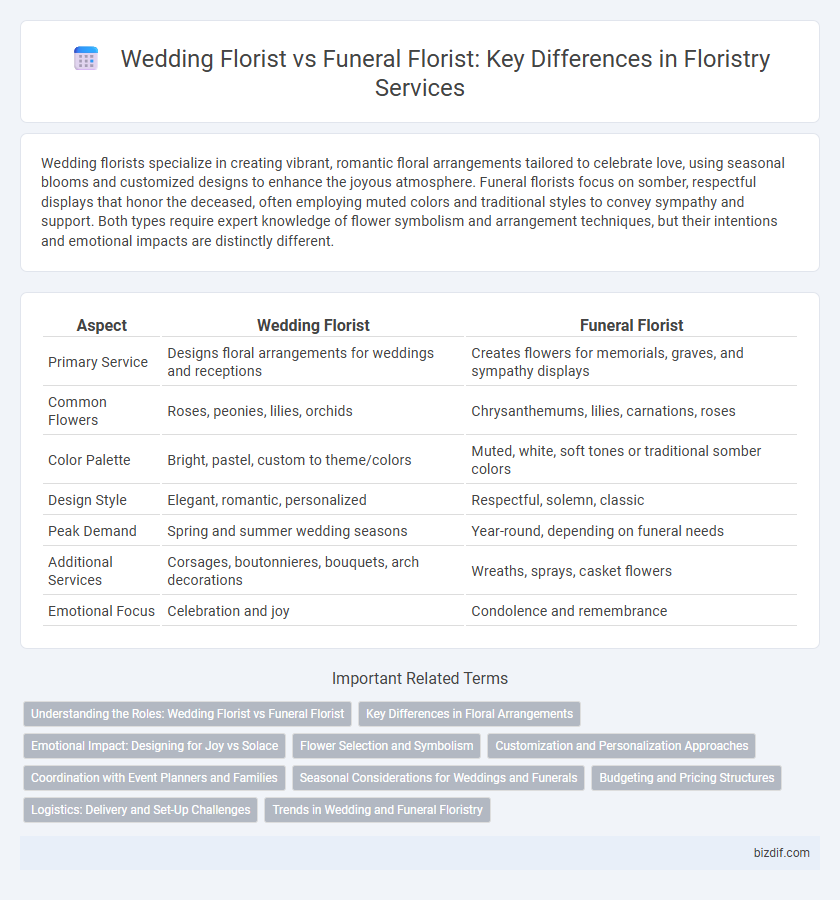Wedding florists specialize in creating vibrant, romantic floral arrangements tailored to celebrate love, using seasonal blooms and customized designs to enhance the joyous atmosphere. Funeral florists focus on somber, respectful displays that honor the deceased, often employing muted colors and traditional styles to convey sympathy and support. Both types require expert knowledge of flower symbolism and arrangement techniques, but their intentions and emotional impacts are distinctly different.
Table of Comparison
| Aspect | Wedding Florist | Funeral Florist |
|---|---|---|
| Primary Service | Designs floral arrangements for weddings and receptions | Creates flowers for memorials, graves, and sympathy displays |
| Common Flowers | Roses, peonies, lilies, orchids | Chrysanthemums, lilies, carnations, roses |
| Color Palette | Bright, pastel, custom to theme/colors | Muted, white, soft tones or traditional somber colors |
| Design Style | Elegant, romantic, personalized | Respectful, solemn, classic |
| Peak Demand | Spring and summer wedding seasons | Year-round, depending on funeral needs |
| Additional Services | Corsages, boutonnieres, bouquets, arch decorations | Wreaths, sprays, casket flowers |
| Emotional Focus | Celebration and joy | Condolence and remembrance |
Understanding the Roles: Wedding Florist vs Funeral Florist
Wedding florists specialize in creating vibrant, celebratory floral arrangements tailored to enhance the joyful atmosphere of weddings, often incorporating seasonal blooms, personalized bouquets, and decorative centerpieces. Funeral florists focus on designing solemn, respectful tributes such as wreaths, sprays, and casket flowers that honor the deceased and provide comfort to grieving families. Understanding the distinct roles of wedding and funeral florists is crucial for choosing appropriate floral services that align with the emotional tone and purpose of each occasion.
Key Differences in Floral Arrangements
Wedding florists specialize in creating vibrant, romantic floral arrangements featuring roses, peonies, and lilies designed to enhance wedding themes and color palettes. Funeral florists focus on respectful, elegant designs using chrysanthemums, carnations, and lilies in muted tones to convey sympathy and remembrance. The key differences lie in the choice of flower types, arrangement styles, and color schemes tailored to celebratory versus solemn occasions.
Emotional Impact: Designing for Joy vs Solace
Wedding florists create vibrant, joyful arrangements that evoke celebration and happiness, using bright colors and fragrant blooms to enhance the festive atmosphere. Funeral florists design somber, comforting displays with muted tones and elegant compositions, aiming to provide solace and honor the memory of the deceased. Both specialties require a deep understanding of emotional impact, tailoring floral designs to support either uplifting moments or respectful remembrance.
Flower Selection and Symbolism
Wedding florists carefully select blooms like roses, peonies, and lilies symbolizing love, purity, and new beginnings, enhancing the romantic ambiance of the ceremony. Funeral florists choose flowers such as chrysanthemums, carnations, and lilies that convey sympathy, remembrance, and eternal life, offering comfort to grieving families. Understanding the symbolism behind each flower type ensures the appropriate emotional tone for weddings or funerals in floral arrangements.
Customization and Personalization Approaches
Wedding florists excel in customization by designing floral arrangements that reflect the couple's unique love story, incorporating specific color palettes, seasonal blooms, and personalized motifs to enhance the celebration's ambiance. Funeral florists focus on personalization by creating respectful, meaningful tributes tailored to honor the deceased's personality, cultural background, and family preferences, often including symbolic flowers and customized messages. Both specialties rely on advanced floral design techniques, but wedding florists emphasize celebratory aesthetics while funeral florists prioritize solemnity and emotional resonance.
Coordination with Event Planners and Families
Wedding florists work closely with event planners and couples to design floral arrangements that match the wedding theme, ensuring seamless integration with decor and timelines. Funeral florists coordinate sensitively with families and funeral directors to create respectful, personalized tributes that honor the deceased within funeral service schedules. Both specialties require strong communication skills and flexibility to meet emotional needs and logistical demands unique to each event.
Seasonal Considerations for Weddings and Funerals
Seasonal considerations for wedding florists center on selecting blooms that reflect the time of year, such as peonies and lilacs in spring or dahlias and sunflowers in autumn, ensuring vibrant and fresh arrangements that complement the wedding theme. Funeral florists prioritize flowers that are traditionally associated with mourning and remembrance, often choosing chrysanthemums in fall and lilies in spring to convey sympathy and respect while adapting to the available seasonal varieties. Both wedding and funeral florists must expertly navigate seasonal availability to maintain flower quality and meet client expectations during peak times.
Budgeting and Pricing Structures
Wedding florists typically offer customizable packages that fluctuate based on floral varieties, arrangement complexity, and event scale, often requiring a higher budget due to seasonality and demand. Funeral florists usually provide fixed-price options for standard wreaths, sprays, or casket flowers, with pricing influenced by flower type and delivery logistics. Understanding these pricing structures helps clients allocate budgets appropriately for tailored wedding designs or respectful funeral tributes.
Logistics: Delivery and Set-Up Challenges
Wedding florists face complex logistics involving timely delivery and intricate set-up to ensure fresh, visually stunning arrangements that align with ceremony schedules and venue requirements. Funeral florists manage urgent deliveries often under tight time constraints, focusing on durability and respectful presentation while accommodating cemetery or funeral home protocols. Both require meticulous planning, but weddings demand precision in design placement, whereas funerals prioritize prompt, sensitive installation.
Trends in Wedding and Funeral Floristry
Wedding floristry trends emphasize vibrant, seasonal blooms and personalized arrangements that reflect the couple's style and venue, often incorporating sustainable and locally sourced flowers. Funeral floristry continues to favor traditional, solemn designs with subdued colors, but modern approaches increasingly include personalized tributes and eco-friendly options like biodegradable wreaths. Both sectors adapt to evolving client preferences, with wedding florists focusing on creative expression and funeral florists balancing respect with meaningful customization.
Wedding Florist vs Funeral Florist Infographic

 bizdif.com
bizdif.com